4 Changing oceans
Norway has jurisdiction over large marine areas that are especially productive and rich in resources, but also vulnerable and undergoing rapid change. It is a challenging task for the Norwegian ocean management authorities to maintain the ecological structure and functioning of these areas, so that they continue to provide a long-term basis for value creation and welfare at a time when the climate, environmental conditions and ocean activities are changing rapidly.
Norwegian seas are part of one continuous ocean system, and changes in other parts of the world’s oceans also influence areas under Norwegian jurisdiction. The entire system is affected by climate change and other large-scale pressures. Further development of Norway’s ocean management system must be based on an understanding of how climate change and other large-scale processes are affecting and will change the world’s oceans and how they are used.
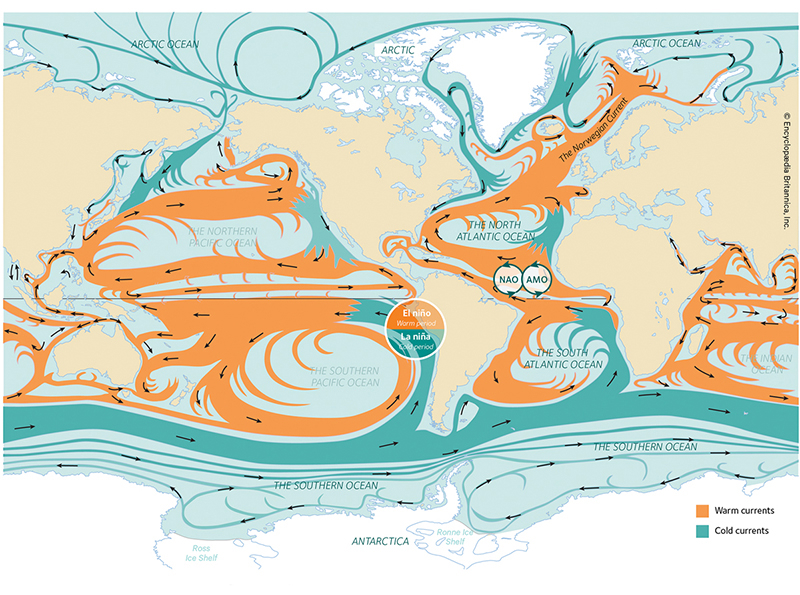
Figure 4.1 Global ocean currents. Norwegian waters form part of a continuous ocean and circulatory system.
Source Norwegian Environment Agency
This chapter describes some of the most important finds in three key scientific reports on these issues, all published in 2019: the IPCC Special Report on the Ocean and Cryosphere in a Changing Climate, from the Intergovernmental Panel on Climate Change, the IPBES Global Assessment of Biodiversity and Ecosystem Services from the Intergovernmental Science-Policy Platform on Biodiversity and Ecosystem Services, and The Ocean as a Solution to Climate Change from the High-level Panel for a Sustainable Ocean Economy. The chapter focuses particularly on conclusions that are relevant to Norwegian waters and possible implications for their management.
The world’s oceans contribute to human well-being by providing resources such as food, minerals and energy, transport routes and a basis for recreation and tourism. The oceans also moderate global warming by absorbing heat and CO2, and act as a sink for pollutants and waste produced by a rapidly growing population and expanding economy. This also means that the global ocean system, from the coastline to the deep sea, is under severe and growing pressure from human activity.
Population growth and increasing prosperity are also creating a demand for more food, energy and other resources from the oceans. The goal of rapid reductions in greenhouse gas emissions is intensifying this, for example increasing demand for production of offshore renewable energy.
It is difficult to predict all the impacts of climate and environmental change and expanding human activity on the oceans. There is therefore growing uncertainty about environmental conditions in the future and whether there is a viable basis for industries that depend on marine ecosystems. This will create new challenges for ocean management at national level and for international ocean cooperation.
Deterioration of the marine environment is also undermining the viability of the ocean economy. The OECD has described degradation of the marine environment as a result of climate change, ocean acidification, overfishing, land- and sea-use change and inputs of pollutants and plastic waste as a serious threat that is limiting opportunities for further development and growth.
4.1 Changing world oceans – drivers of change and impacts
IPBES has estimated that more than 40 % of the world’s ocean area is already strongly affected by human activity, and that cumulative impacts are increasing across two thirds of this area. There are wide variations between different areas. Coastal marine ecosystems in densely populated areas and in tropical waters are under the greatest pressure. However, climate change is also putting considerable pressure on the polar seas.
According to IPBES, there are four main direct drivers of change in marine ecosystems. The most important of these globally is fishing and other harvesting of marine organisms, followed by land- and sea-use change, including the development of infrastructure and aquaculture in the coastal zone. The third driver is climate change, and the fourth is inputs of pollutants and waste. The relative importance of these drivers varies between different parts of the world’s oceans. In Norwegian waters, climate change is the most important driver.
Climate change is also the driver that is intensifying most rapidly worldwide. According to IPBES, it is likely that the cumulative impacts of climate change, in combination with the changes in the use of marine and coastal waters, overexploitation of living resources, pollution and the spread of alien species will further exacerbate negative impacts on ecosystems. The Arctic is highlighted as one of the regions where this can already be observed.
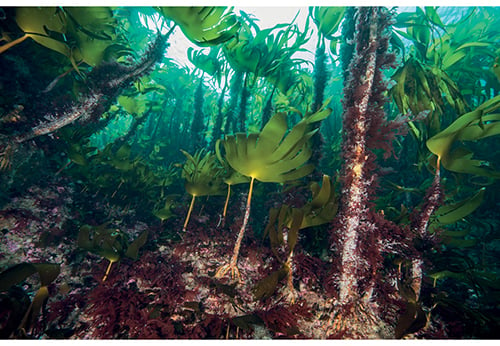
Figure 4.2 Kelp forest in Norway.
Photo: Erling Svensen
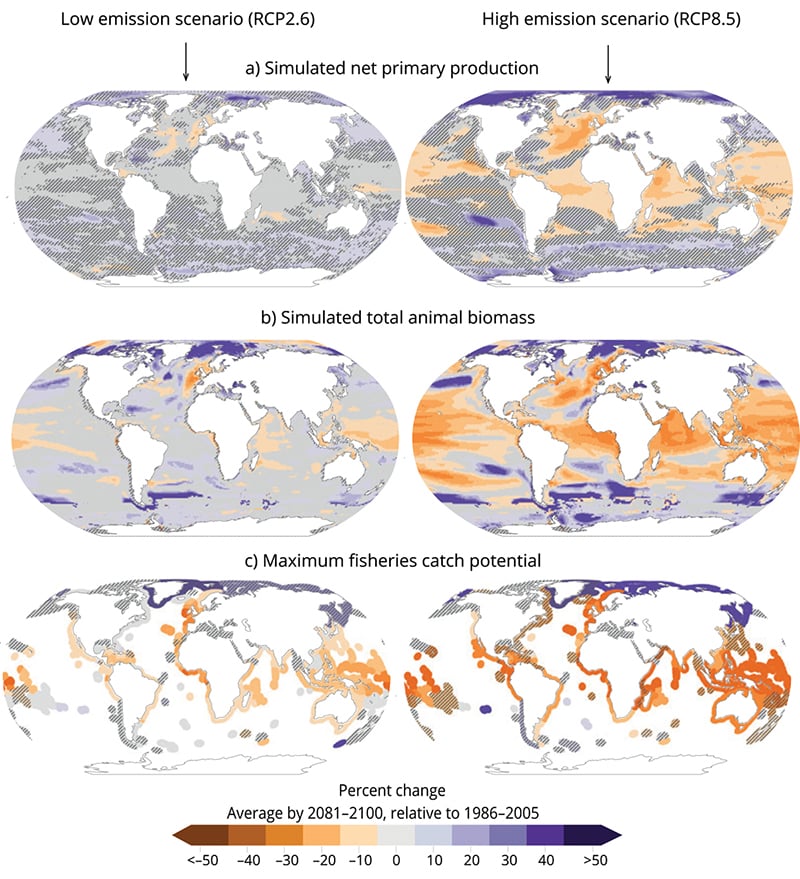
Figure 4.3 Projected changes in the world’s oceans by the end of this century: a) net primary production, b) total animal biomass, and c) maximum fisheries catch potential. Purple indicates a rise and orange a decline. The two sets of diagrams show, left, a low-emission scenario (RCP2.6), and right, a high-emission scenario (RCP8.5). Shaded areas indicate where there is disagreement between models, and white areas where there is a lack of data. Although the Arctic and Antarctic regions are not shaded in b) and c), there is considerable uncertainty associated with how different drivers interact and ecosystem responses in these regions.
Source IPCC
IPCC reports show that climate change will have major impacts both on the oceans and on our use of them. The oceans have taken up more than 90 % of the excess heat from anthropogenic global warming since 1970, and 20–30 % of total anthropogenic CO2 emissions since 1980. The rate of ocean warming has doubled in the past 25 years. The IPCC concludes that the oceans are entering a new state, with rising temperatures, more acidic seawater, less oxygen, lower biological production and changes in ocean circulation. Global sea level is expected to rise rapidly.
According to the IPCC report, marine and coastal areas at lower latitudes will be hardest hit. However, important marine ecosystems in Norwegian waters are also vulnerable to rising temperatures and ocean acidification. These include kelp forests, eelgrass meadows, cold-water coral reefs and ecosystems associated with the Arctic sea ice. Figure 4.4 shows the vulnerability of different marine ecosystems to climate change.
Globally, biological production in the oceans is expected to decline as the oceans warm. The decline will be greatest in tropical seas (Figure 4.3). At the same time, the distribution of areas of suitable habitat for many species will shift towards the poles. Seawater will become increasingly acidic as it absorbs more CO2. These trends will result in major changes in marine ecosystems. The IPCC has estimated that the global catch potential of fisheries may be reduced by up to 25 % by 2100 if greenhouse gas emissions are not reduced. In this case too, the reduction is expected to be greatest in the tropics. Changes in catch potential in polar waters are expected to vary, and may be positive in certain areas (Figure 4.3).
The changes we have witnessed so far in the North Sea and the Barents Sea, where biological production has declined in southerly areas and increased further north in response to higher seawater temperatures, are in line with the expected large-scale changes described by the IPCC.
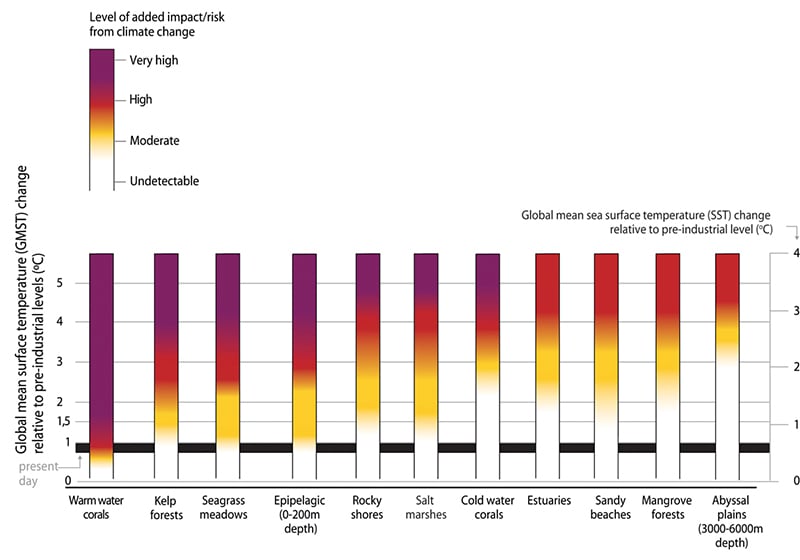
Figure 4.4 Assessment of impacts and risks for coastal and open ocean ecosystems under global warming. The left-hand y axis shows the rise in global mean surface temperature. The right-hand y axis shows the corresponding rise in global mean sea surface temperature. Temperature rise is relative to pre-industrial levels. The black band shows the present-day temperature.
Source IPCC
As the oceans warm, there is a rise in the frequency of marine heatwaves, or periods when seawater temperatures are extremely high. Their frequency has already risen considerably, and by the end of this century, they are expected to occur 20–50 times as often as at present. Tropical and Arctic waters are particularly vulnerable to such episodes. The rising frequency of marine heatwaves has already resulted in serious damage to tropical coral reefs.
At higher latitudes, kelp forests are among the ecosystems that are affected, particularly in the southern parts of their distribution. This is already clearly apparent in the Skagerrak, where marine heatwaves have in recent decades been a contributory factor in the serious decline in the distribution of sugar kelp (Saccharina latissima). While kelp forests may be lost in more southerly areas, their range may expand in the Arctic. This is consistent with the recovery of kelp forests that has been observed off the coast of Trøndelag and Nordland. Kelp forests are important nursery areas for fish and a vital habitat for a large number of marine species. Changes in the distribution of kelp forests may therefore result in major changes in ecosystems both further south and in Arctic waters.
In the Arctic seas, major changes can already be observed as a result of warmer seawater and the loss of sea ice. Since 1979, there has been a decline in sea ice in all seasons. In the period 1979–2018, sea ice extent in September declined by 12.8 % per decade. This is the most rapid decrease for at least 1000 years.
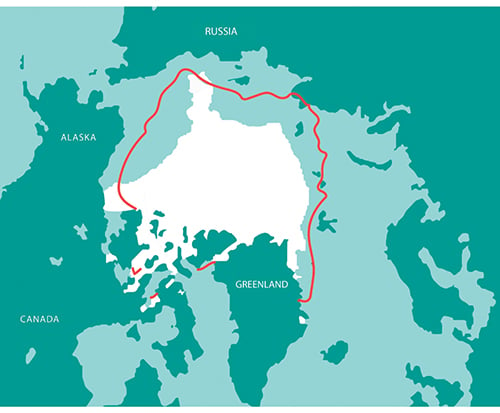
Figure 4.5 The map shows sea ice extent in the Arctic (white area) in September 2018. The red line shows the 1981 to 2010 average extent for the same month. Based on satellite images and the Sea Ice Index from the US National Snow & Ice Data Center.
Source Norwegian Environment Agency
The Barents Sea is one of the areas where sea ice is being lost most rapidly, and a steep downward trend has been observed in winter as well. As the seawater has become warmer, the distribution of temperate species has expanded, while that of Arctic fish species and ice-dependent species has shrunk, see Chapter 3. Species such as cod, haddock and mackerel have expanded their range hundreds of kilometres northwards. The rapid loss of sea ice in the Barents Sea since satellite measurements started in 1979 is believed to be the result of a combination of global warming and natural climate variability, since there was a cold period in the late 1970s.
According to the IPCC, the suitable habitat available to polar species will continue to shrink as a result of climate change, while the distribution of temperate species will continue to expand northwards. The loss of multi-year ice will also have an effect on primary production and biodiversity. This will have impacts on ecosystems in the marginal ice zone, on the seabed and in the open sea.
Changes in marine ecosystems are being amplified by ocean acidification, which is a result of the uptake of a proportion of anthropogenic CO2 emissions by seawater. Both the risk to ecosystems and uncertainty about future trends are greater when ocean acidification is taken into account. Cold water can absorb more CO2 than warmer water. This makes Arctic waters particularly vulnerable, and ocean acidification is widespread and rapid in the region. According to the IPCC, the area of the Arctic Ocean where calcium saturation is so low that calcium dissolves has expanded. This may have impacts on calcifying organisms. In Norwegian waters, acidification has been registered in the Norwegian Sea, but not so far in the Barents Sea.
It is considered highly likely that there will be substantial changes in marine Arctic ecosystems as a result of ocean acidification, and that there will be both direct and indirect impacts on marine organisms. Recent modelling suggests that ocean acidification will increase and there will be a steady decline in pH during this century, and abrupt changes in acidity level are projected in the Nordic seas and the Arctic in the period up to 2065. This may have impacts both on interspecific competition and on the relationships between different trophic levels in food chains.

Figure 4.6 Projected distribution of aragonite undersaturation caused by ocean acidification towards the end of this century. Red shading indicates the areas where greatest acidification is expected. The two maps show a low-emission scenario (left, RCP2.6) and a high-emission scenario (right, RCP8.5). They show areas where year-round aragonite undersaturation is projected in the upper water layers in the period 2081–2100. More acidic seawater and aragonite undersaturation may have negative impacts on important marine species that are dependent on calcium to build their skeletons or shells, and thus alter marine ecosystems.
Source IPCC
Rising CO2 emissions are the most important cause of both global warming and ocean acidification. Both of these processes will therefore intensify as the atmospheric concentration of CO2 rises. Interactions between ocean acidification and global warming thus have important implications for the marine environment in the future. This is particularly true in the Arctic, where both warming and acidification are occurring most rapidly. Although we can be reasonably certain that northern seas will become both warmer and more acidic as a result of greenhouse gas emissions, there is still considerably uncertainty about the future impacts on marine organisms and the socio-economic consequences of this.
According to the report AMAP Assessment 2018: Arctic Ocean Acidification from the Arctic Council, current knowledge indicates that ocean acidification will drive changes in Arctic species and ecosystems at a magnitude that will affect people and communities. The report presents five case studies exploring the socio-economic impacts of ocean acidification and warmer seawater on fisheries in Greenland, Canada, Alaska and Norway, and concludes that the changes will pose considerable risks, although new opportunities may also arise. For Norwegian waters, the Barents Sea cod stock has been modelled to examine how the combination of climate change and ocean acidification may affect the cod fishery. The results indicate that the catch potential may be reduced by 80 % by 2100 if CO2 emissions continue to rise. These results are based on data from laboratory experiments, and have not yet been confirmed by documented real-world effects. There is considerable uncertainty concerning the results of all five case studies. Nevertheless, they give an idea of possible consequences, and of the risks and possible new opportunities associated with climate change and ocean acidification in Arctic seas.
Cold-water corals (Figure 4.7) are particularly vulnerable to ocean acidification, and could in the worst case die out or be outcompeted by other species that are more resistant to acidification. Cold-water coral reefs are important ecosystems in Norwegian waters, and provide food and habitats for many species, including tusk, saithe and redfish.
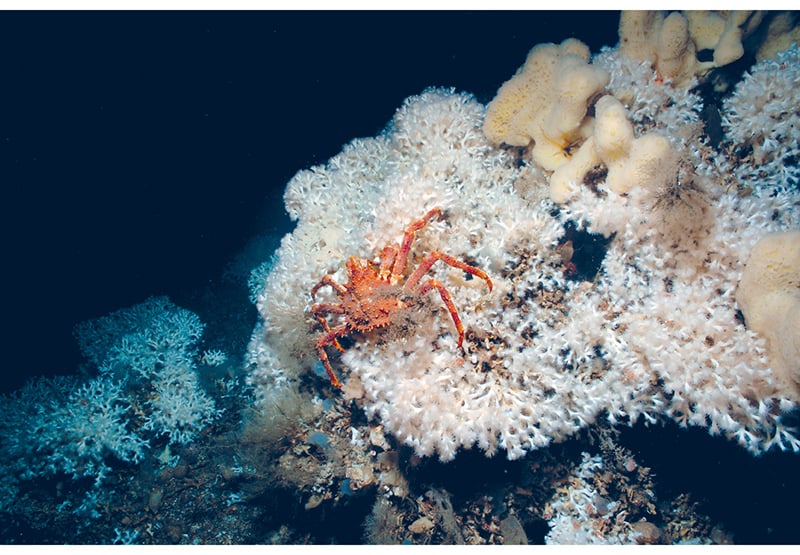
Figure 4.7 Cold-water coral reefs are a habitat for a wide variety of species.
Photo: Erling Svensen
The IPCC report shows that climate change, particularly in combination with inputs of nutrients, may be the reason for the observed increase in the frequency of toxic algal blooms in many areas, including the North Atlantic. This trend may have implications for the Norwegian aquaculture industry in future. Climate change may also increase the accumulation of hazardous substances in marine plants and animals, for example in the Arctic.
As the sea temperature rises, there is a northward shift in the areas that are most suitable for salmon farming, and the most southerly areas become less suitable. The Nofima research institute has analysed projected temperature trends in Norway’s aquaculture regions up to 2070, and has concluded that warmer water may become a problem for farmed salmon in the southern part of the country even in a low-emission scenario.
Climate change will also have impacts on the major ocean currents and their influence on the climate system. The main current system in the Atlantic Ocean, the Atlantic Meridional Overturning Circulation (AMOC) which includes the Gulf Stream and the Norwegian Atlantic current, has already been weakened. This trend is expected to continue. Any substantial weakening of this system will, according to the modelling results used by the IPCC, result in lower biological production in the North Atlantic and an increase in the number of storms in Europe.
The IPCC’s projections of climate and environmental change correspond well with trends in climate and environmental variables that can already be observed and measured today, both in Norwegian waters and elsewhere in the world. Both projections and observations show that climate change poses a considerable risk to ecosystems in Norwegian waters and to Norwegian seafood production. This risk will be far greater in the long term if emissions continue to rise than if we achieve rapid cuts in global emissions.
4.2 Climate change mitigation measures will also have impacts on the oceans
Climate change and ocean acidification are altering the ecological basis for exploiting ocean resources; at the same time, action to achieve the necessary emission reductions will intensify the need to make use of the oceans, for example to increase production of food and renewable energy. This will have implications for marine spatial management and may intensify pressure on the marine environment.
It is possible to produce food from the oceans with a relatively low environmental and carbon footprint. Food production from the oceans can be considerably increased if the marine ecosystems that provide the basis for this production are safeguarded. The greatest potential for increasing sustainable food production from the sea lies in expanding aquaculture. There is also a large unused potential for energy and mineral production from the oceans. Renewable energy from the oceans and carbon storage under the seabed will need to be a vital part of the solution if the world is to achieve the Paris Agreement goal of holding the global temperature increase to well below 2 °C.
At the Climate Action Summit held in conjunction with the UN General Assembly in 2019, the High-level Panel for a Sustainable Ocean Economy called on the world to step up ocean-based mitigation action to support the implementation of the Paris Agreement and the Sustainable Development Goals. The High-level Panel emphasised that ocean-based climate action could deliver up to one fifth of the emission reductions needed to limit global warming to 1.5 °C. The call was based on the conclusions of a special report commissioned by the High-level Panel. This estimate is very uncertain, and much more research is needed to confirm it, but the report shows that the ocean economy and ocean management can play an important role in reducing greenhouse gas emissions and implementing the Paris Agreement.
The mitigation potential is split between five main areas: ocean-based renewable energy; ocean-based transport; coastal and marine ecosystems; fisheries, aquaculture and dietary shifts; and carbon storage in the seabed.
There are strong Norwegian strong research groups and administrative bodies in these areas, and the business sector is at the forefront of developments, putting the country in a good position to lead the way. However, increasing production of food and renewable energy from the oceans could have a substantial environmental footprint and occupy large areas of ocean.
A Norwegian review of mitigation measures has been published analysing their potential for reducing emissions of greenhouses gases that are not included in the EU Emissions Trading System by 2030. The analysis was carried out by the Norwegian Environment Agency, the Norwegian Public Roads Administration, the Norwegian Coastal Administration, the Norwegian Agricultural Agency, the Norwegian Water Resources and Energy Directorate and Enova. The report identified measures that could reduce emissions from shipping, fisheries and aquaculture by 6.6 million tonnes CO2 equivalent in the period up to 2030. According to the report, intensifying efforts to speed up the transition to low- and zero-emission solutions in these industries will be important in achieving Norway’s climate target for 2030. Increasing food production from the oceans may also play a part in reducing greenhouse gas emissions. Dietary measures, which include increasing consumption of seafood, and measures to reduce food waste, are estimated to have emission-reduction potentials of 2.9 and 1.5 million tonnes CO2 respectively.
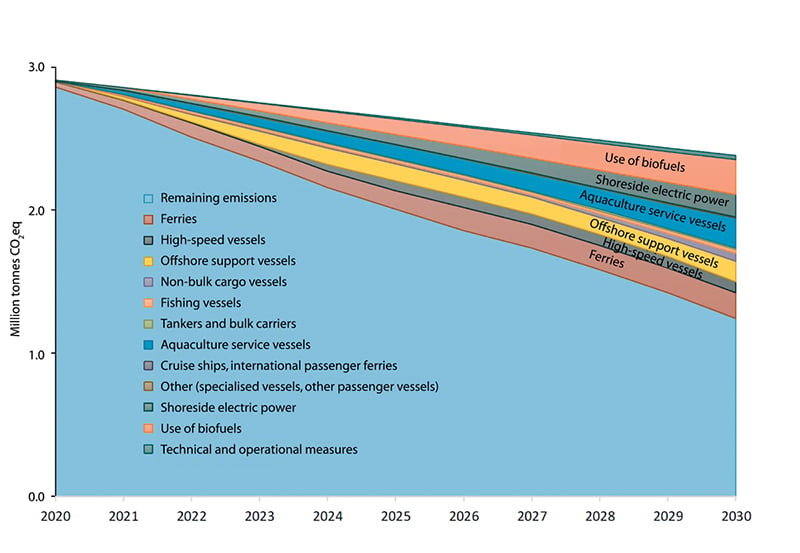
Figure 4.8 Emission reduction potential of mitigation measures for shipping for the period 2021–2030.
Source Norwegian Environment Agency
Economic growth and new technologies intended to reduce greenhouse gas emissions will require access to greater quantities of minerals. Examples include battery production and long-distance electricity transmission. Even if recycling is increased and a more circular economy is developed, mineral extraction will need to be expanded. There is therefore growing interest in the exploitation of seabed mineral resources, and Norway has recently adopted national legislation in this area. This is yet another activity that may affect the marine environment.
These developments highlight both the potential and the challenges related to spatial management and possible environmental impacts as the world makes more use of the oceans to reduce global greenhouse gas emissions.
4.3 Implications for ocean governance
Both the IPCC and IPBES have concluded that ocean governance must be adapted to the accelerating pace of climate and environmental change. Ocean governance must take into account the possible impacts of climate change in combination with other drivers of change, and it must be possible to adapt quickly as the situation changes. As climate change and ocean acidification intensify, it will be more difficult for administrative authorities to ensure that overall patterns of use and resource exploitation are sustainable, and to deal with new and intersecting user interests and possible conflicts related to changes in the distribution of living marine resources. And not least, it will be an increasingly challenging task to understand and limit the cumulative impacts of different activities in ways that maintain good environmental status. It will therefore be a vital task to ensure that ocean management authorities in Norway have the capacity and sufficient flexibility to deal with the accelerating pace of change.
One important message from the IPCC is that the higher the pace of climate change and the more adaptation action is delayed, the more difficult it will be to adapt successfully, and the less likely it is that adaptation will be successful. In the longer term, successful ocean governance and climate change adaptation will be dependent on success in bringing about rapid cuts in global greenhouse gas emissions and on taking early adaptation action. Thus, there are crucial links between climate policy, mitigation measures and efforts to ensure integrated ocean management in Norwegian waters.
This highlights the need to exploit the potential of the oceans and the ocean economy to play a part in climate change mitigation. According to the IPCC, the scale and speed of the impacts of climate change on the oceans will be such that it will be difficult for many communities to adapt to them, and for public authorities to respond adequately. In particular, the IPCC points out that governance systems are often too fragmented and poorly integrated across sectors and administrative divisions, making it difficult to respond in a way that is commensurate with the challenges facing us. Norway’s ocean management plans stand out in this context because of their cross-sectoral approach. Norway’s fisheries management regime also stands out because it is constantly adapted to the latest available knowledge about stocks and ecosystems, which is obtained from marine research groups and institutions and the International Council for the Exploration of the Sea (ICES).
IPBES has assessed what will be needed to manage the cumulative impacts of various drivers on the oceans. It concluded that what is needed is a mix of policy instruments and measures to conserve fish stocks and marine species and ecosystems, implemented on land, in freshwater and in the oceans. Coordination across sectors and stakeholders on the use of open oceans will also be needed. One type of action that IPBES highlights as effective is the expansion and strengthening of representative networks of protected areas, provided that they are well managed. Others are ecosystem-based management, effective fisheries quota systems, marine spatial management, protecting key marine biodiversity areas, reducing pollution from land and working closely with producers and consumers.
The IPCC emphasises that adaptation of ocean governance frameworks to make them climate-resilient to a large extent involves reducing or limiting other direct drivers of change in marine and coastal environments, such as land- and sea-use change, pollution and harvesting. Conservation of ecosystems through area-based measures, including developing networks of protected areas on land and at sea, is highlighted as particularly important. This can help to reduce cumulative impacts on areas and ecosystems that are given special protection, and to protect areas that will become important as the distribution of species and ecosystems changes in response to climate change.
The climate is changing most rapidly in the polar regions, and according to the IPCC, this poses risks to commercial and subsistence fisheries in the Arctic. This may have implications for regional economies and communities and for global supplies of fish and seafood. If emissions remain high, current management strategies may not make it possible to sustain current catch levels for some commercially valuable stocks. The IPCC noted that the capacity of governance systems in the Arctic and many other ocean regions has been strengthened, but nevertheless concluded that this is not happening rapidly enough to address the projected changes.
Both the IPCC and IPBES identify ecosystem-based management of the oceans and marine resources as an important approach for addressing climate change. This is also the fundamental approach of Norway’s ocean management plans and of management of marine resources as set out in the Marine Resources Act.
The cross-sectoral system of integrated ocean management plans combined with sound management within each sector puts Norway in a good position to deal with the challenges arising from rising activity levels and rapid climate and environmental change. The length of Norway’s coastline from north to south is also a good starting point for adapting management systems to the shifts in the distribution of species and ecosystems that are being driven by climate change.
However, it will be vital to continue the development of Norway’s management regime in order to address these challenges. We must for example take into account changes to marine ecosystems and species distribution resulting from climate change and ocean acidification, which may make many species and ecosystems more vulnerable to other pressures. This will require research to understand climate change and its impacts on the oceans, and monitoring to make it possible to detect changes at an early stage; the public administration will also need systems in place to enable a rapid response to new information, including necessary measures.